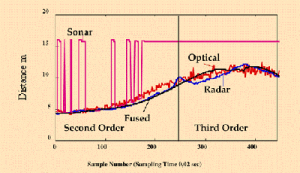People Team
Abstract
We have developed a framework for real time monitoring and diagnosis of automated vehicles in IVHS. This supervisory control methodology is concerned with fault detection, fault isolation, and control reconfiguration of the many sensors, actuators and controllers that are used in the control process. The supervisory control architecture operates at two levels of the AVCS: at the regulation and at the coordination level. Supervisory control activities at the regulation layer deal with validation and fusion of the sensory data, and fault diagnosis of the actuators, sensors, and the vehicle itself. Supervisory control activities at the coordination layer deal with detecting potential hazards, recommending the feasibility of potential maneuvers and making recommendations to avert accidents in emergency situations. The supervisory control activities are achieved through five modules, organized in an hierarchical manner.
Due to the inherent noise of the sensor measurements, the latter are uncertain. Even if several sensors are used, it is not straight forward which sensor to trust or to what degree to trust it. If untreated, the quality of the ride suffers (as demonstrated in this animation) and in the worst case leads to unsafe conditions. Two different approaches for validation and fusion have been investigated: 1.) a probabilistic approach, and 2.) a fuzzy approach. The probabilistic approach is Kalman Filter based and assumes Gaussian noise distributions while the fuzzy approach makes no such assumptions. For fusion, the fuzzy approach uses validation gates which allow the assignment of confidence values to each sensor reading, depending on the sensor characteristics particular to each sensor.
Diagnosis of the sensors is performed on-line via fuzzy abductive methods. A ranking scheme calculates fuzzy closeness measures which are used to obtain the most likely failure (if any).
Below you can see validated and fused values for longitudinal distance as well as the original sensor values obtained from radar, sonar, and optical sensors.

PublicationsA. Agogino, S. Alag, K. Goebel, ” A Framework for Intelligent Sensor Validation, Sensor Fusion, and Supervisory Control of Automated Vehicles in IVHS“, Intelligent Transportation: Serving the User through Deployment, Proceedings of the 1995 Annual Meeting of ITS America, pp. 77-87, 1995.- S. Alag, K. Goebel, A. Agogino, ” A Methodology for Intelligent Sensor Validation and Fusion used in Tracking and Avoidance of Objects for Automated Vehicles“, Proceedings of the ACC 1995 conference, Seattle, WA, June 1995.
- A. Agogino, K. Goebel, S. Alag, ” Intelligent Sensor Validation and Sensor Fusion for Reliability and Safety Enhancement in Vehicle Control“, MOU132, Final Report, UCB-ITS-PRR-95-40, California PATH Research Report, 1995. (POSTSCRIPT FORMAT! tested on Ghostscript 2.6.1 only)
- Alag, S, Agogino, A., Morjaria, J., and Hsueh, W.-J. “ A Methodology for Intelligent Sensor Measurement Validation, Fusion, Sensor Fault Detection for Complex Processes“, BEST lab working paper #95-0802-2, UC Berkeley, 1996.
- Alag, S. and A.M. Agogino, “ Change Detection and Incipient Fault Prediction Using Probabilistic Networks“, BEST lab working paper #95-0803-1, UC Berkeley, 1996.
- Alag. S. and A.M. Agogino, “ Inference Using Message Propagation and Topology Transformation in Vector Gaussian Continuous Networks “, Proceedings of the UAI ’96, Portland, Oregon, 1996.
- Goebel, K. and A. M. Agogino, “ An Architecture for Fuzzy Sensor Validation and Fusion for Vehicle Following in Automated Highways“, Proceedings of the 29th ISATA, Florence, Italy, 1996.
- Alag, S., “ A Bayesian Decision-Theoretic Framework for Real-Time Monitoring and Diagnosis of Complex Systems: Theory and Application “, Ph.D. Thesis, UC Berkeley, 1996.
- Bellm, D., “Characterization of the Sonar and Radar Distance Sensing Devices under Sub-Optimal Operating Conditions for the California Partners for Advanced Transit and Highways”, Masters Report, UC Berkeley, 1995.
- Villanueva, I. “ Fault Tree Analysis for Longitudinal Sensors in IVHS “, SUPERB 1996 Final Report, UC Berkeley, 1996.
- Alag. S. and A.M. Agogino, “ Learning Temporal Probabilities Using Recursive Least Square Adaptation In Dynamic Belief Networks“, BEST lab working paper #96-0202-2, UC Berkeley, 1996.
- Goebel. K., “Management of Uncertainty for Sensor Validation, Sensor Fusion and Diagnosis in Sensor Driven Mechanical Systems Using Soft Computing Techniques“, Ph.D. Thesis, UC Berkeley, 1996.
- Cammon, B., “Integration of Sensor Validation and Fusion with SmartPATH: A Process and Performance Evaluation“, Masters Report, UC Berkeley, 1996.
- Goebel. K., and Agogino, A., “Fuzzy Influence Diagrams”, submitted to the International Journal of Uncertainty, Fuzziness, and Knowledge Systems”, working paper # 97-0205-0, BEST lab, UC Berkeley, 1997.
- Goebel, Kai, S. Alag and A.M. Agogino, “Probabilistic and Fuzzy Methods for Sensor Validation and Fusion in Vehicle Guidance: A Comparison,” Submitted to ISATA ’97. working paper # 97-0204-1, BEST lab, UC Berkeley, 1997.
- Goebel, Kai and A.M. Agogino, “Fuzzy Diagnosis for Reliability and Safety Enhancement in Automated Vehicles,” submitted to Information Sciences, working paper # 97-0206-0, BEST lab, UC Berkeley, 1997.
- Goebel, Kai and A.M. Agogino, “Sensor Validation and Fusion for Gas Turbine Power Plants Using Fuzzy Techniques,” submitted to Mechanical Systems and Signal Processing, working paper # 97-0207-0, BEST lab, UC Berkeley, 1997.
- Goebel, Kai and A.M. Agogino, “Intelligent Sensor Validation and Sensor Fusion for Automated Vehicle Control Using Fuzzy techniques,” submitted to the ASME Trans., Journal of Dynamic Systems, Measurement and Control, working paper # 97-0208-0, BEST lab, UC Berkeley, 1997.
- Agogino, A., Goebel, K., and Alag, S., “ Intelligent Sensor Validation and Fusion for Vehicle Guidance Using Probabilistic and Fuzzy Means MOU157, Final Report, D97-29, 1997.



